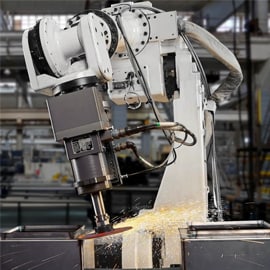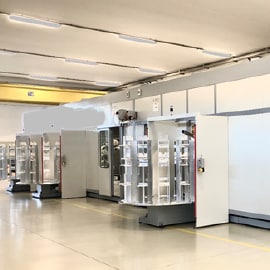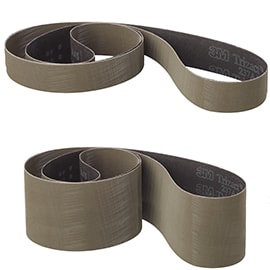-
Shop Talk - The role of robotics in abrasives.
August 24, 2020
The role of robotics in abrasives.

Robotics has been used in manufacturing for many years now. They provide an automated solution that can perform dangerous and repetitive tasks with acute precision. We all know that robots can be used to weld and for pick and place activities, but did you know that robots can be programmed for grinding and polishing operations? There’s a perception in the industry that these tasks, especially the art of high-end finishing, cannot be automated. Today, however, any polishing, grinding or finishing application can be automated. When it comes to these abrasive applications, industrial robots can carry out these labour-intensive tasks with a high degree of accuracy and reliability to increase productivity and workplace safety.
Let’s talk shop: Polishing with robotics.
The polishing process is repetitive and tedious, one that requires meticulous precision and highly skilled labour to produce the desired finish. Robotic solutions are an ideal way to improve safety, quality and consistency in the polishing process of any fabrication operation. When combined with the correct abrasives, robots are capable of finishing even the most complex of geometrical workpieces.
Tech tips, Nathan says:
- Robotic deburring and finishing provide exciting opportunities for manufacturers to:
- Increase productivity
- Mitigate the challenges of a shrinking workforce
- Increase efficiency and consistency
- Long-term Cost Savings
- Before embarking on the robotic automation pathway consider the following:
- How should I evaluate a system integrator?
- What are the technical design factors for a successful robotic cell?
- Is my process a good candidate for automation?
- Many industrial production processes can benefit from Robotics. Robotics can be complicated but its absolutely doable if it makes sense in your operation. Reach out for assistance to get started as we have the expertise, connections and products to help you succeed and get started.
Advanced Robotics, a global collaboration.

INTEC Robotics3M faces new challenges with their customers, carrying out intense collaborations driven by shared objectives and operational efficiencies. An approach strengthened by the support provided through our network of 200 worldwide subsidiaries, one that allows our technical and commercial staff to maintain close contact with customers on a global scale. An example of how 3M operates is demonstrated through a recent project relating to our “Advanced Robotics” technology platform, in which 3M used traditional robotic processing to develop technologies targeting the optimisation of industrial production processes at ABCOR.
ABCOR, an Australian company and industry leader in the fabrication and assembly of metal, aluminium and stainless steel parts for the OEM transport industry, recently worked with 3M to incorporate advanced automation in their operation.
Their set up was made possible by their collaboration with 3M’s Italian abrasives team, INTEC Robotic, a leading Italian company in the production of robotic cells and 3M Australia.
Taking advantage of the best skills, experiences and resources, regardless of geographical location, ABCOR developed a highly automated process for the polishing of mirrors and stainless steel sports-bars.
Can your process benefit from automation?
Not sure if your process can be automated? Or maybe you’re just curious what robotic deburring looks like. Watch the video simulations below to see what robots are capable of when they’re equipped with 3M abrasives.
3M™ Trizact™ Cloth Belt 237AA Grinding Belt.
3M™ Trizact™ Abrasives have three-dimensional structures containing multiple layers of abrasive mineral. As these tiny pyramid-like structures wear, fresh, sharp mineral is continually exposed to produce uniform and predictable finishes, every time. This creates consistent performance and eliminates belt-to-belt variation. Trizact™ abrasives are ideal for work where consistent refined finishes are essential, making the Trizact™ Cloth Belt 237AA ideal for use in robotic applications.
Features and benefits:
- Consistent, predictable finishes
- Higher, more even rates of cut
- Cooler finishing temperatures
- Reduced processing steps
- Durable cloth backed construction for control, conformability, and effective medium-pressure grinding
If you have any questions or for more information about Trizact™ Cloth Belt 237AA Grinding Belt to meet the needs of your specific robotic application contact your 3M Abrasive System Specialist or explore our Robotics Resource Toolkit.
About Nathan Bamford.
Nathan Bamford is 3M’s Application Engineer for the Abrasive Systems Division, Australia and New Zealand. He provides technical end user guidance and advice around the selection, use and maintenance of abrasive products and systems.
Nathan has a Bachelor of Mechanical Engineering and has been with 3M for ten years across a variety of businesses, from Automotive OEM, Industrial Adhesives and Tapes, Aerospace, and Abrasive Systems.
Nathan has a fascination with how things work and possesses extensive experience, knowledge and skills in optimising processes. He is passionate about how using quality abrasive products can improve both efficiencies and safety.
- Robotic deburring and finishing provide exciting opportunities for manufacturers to:

